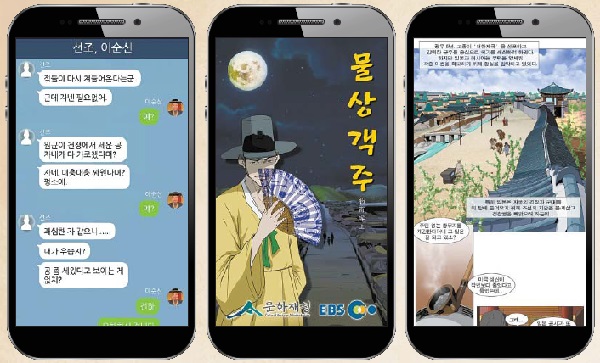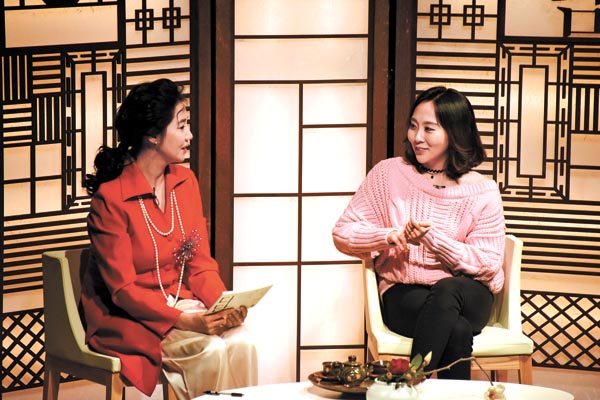Bringing history to life through webtoons

Webtoons dealing with Korean history, historical figures and cultural heritage are gaining popularity among young Koreans. Webtoonist Byun Ji-min’s “True Talks of the Joseon Dynasty,” left, is currently being updated on Naver, while the Cultural Heritage Administration’s has launched a new webtoon on national treasures by Park Seong-jae, center. Park’s previous work for Kakao Webtoon “Susajeon” (2012), right, is a detective story set in the late Joseon Dynasty. [screen captures]
“That is why students easily lose interest in the subject,” says Byun Ji-min, the creator of a popular webtoon series titled “True Talks of the Joseon Dynasty.”
Byun is 27 and is still a student at Seoul National University majoring in visual design, but has been on a long leave of absence due to her busy schedule working as a webtoonist, having to update her series twice a week. Unlike other webtoon artists, Byun has to thoroughly study history in order to create hers as it’s based on the “Annals of the Joseon Dynasty” (1392-1897).
Using the actual records of the Joseon Dynasty (1392-1910), Byun says she was able to realize the characteristics and personalities of the rulers, which are not taught at school. So her webtoon is the 21st-century version of the Joseon Dynasty’s official records, which are captured in KakaoTalk messages in modern language that is understandable by young readers.

Webtoonist Byun Ji-min, right, talks to Park Jeong-sook, left, the host of Dadam, a traditional music concert organized by the National Gugak Center last Tuesday. [NATIONAL GUGAK CENTER]
According to Byun, while reading the “Annals of the Joseon Dynasty,” she realized how King Sejong (1397-1450) was also an ordinary person like any of us, who liked meat so much that he often complained about how there was more meat on his courtiers’ dinner table than his.
“When I read that, it was so funny,” said Byun. “He suddenly became this familiar character to me.”
To Byun, King Sejong was a meat lover who always complained about food, and a domineering leader who always made his servants work until late at night.
One of her episodes of “True Talks of the Joseon Dynasty” deals with such characteristics of King Sejong, with him sending angry KakaoTalk messages to his royal kitchen servant about the amount of meat on his plate. Moreover, Byun says she tries to be as detailed and consistent as possible throughout the series, as she deals with the same characters across several episodes.
For example, she never makes a spelling mistake in the messages King Sejong sends since he’s the founder of the Korean alphabet, but she never includes spaces in the messages from King Taejo (1335-1408) - the first king of the Joseon Dynasty - to his son, Yi Bang-won, to show that he is an elderly father who is not really familiar with mobile messengers.
“When he established the Joseon Dynasty, he was well up in years so I imagined he would be unfamiliar with smartphones and mobile messengers like the old fathers of today,” said Byun. “Many of them don’t insert spaces between words and have many typos, so I wanted to show that.”
Byun has been uploading “True Talks of the Joseon Dynasty” since late 2014, and she’s on her 114th episode as of last Tuesday.
She still reads over and over the translated version of “Annals of the Joseon Dynasty,” which was completed after decades of work in 2006.
“It’s still difficult but because there are so many stories hidden within that I didn’t know, it gets better and better and easier as I read it each time,” she said.
Before beginning her series, she outlined the characteristics and personalities of all 27 kings of the Joseon Dynasty, including their speaking habits.
For example, Byun said the official records say that King Jeongjo (1752-1800) was a self-assertive man who used a lot of foul language with his courtiers. In fact, the records say “he used words that cannot be written down.” So for her depiction of King Jeongjo, she used a lot of slang used by teenagers on the Internet today.
“I think this kind of aspect - setting up Joseon characters using mobile messengers and using today’s language and so on - strikes a chord with young Koreans,” said Byun, explaining why her webtoon is one of the most-read series on Naver.
There have been concerns from some, including Byun herself, about depicting such great historical figures as too comical and human-like, but, surprisingly, historians, teachers and experts alike have welcomed Byun’s attempt, saying that that’s exactly how they really were and even thanking her for increasing public interest.
“They became my mentors,” said Byun. “Because I don’t want to make this webtoon as study material but only as a tool to draw interest to these characters and to increase familiarity with them, I tend to take out some of the details and difficult parts that are within that story. Then these experts explain them underneath the webtoon as long comments for others to read as additional information. That is so cool.”
One of Byun’s and her readers’ favorite episodes is the one on Admiral Yi Sun-sin.
“Before reading the ‘Annals of the Joseon Dynasty,’ I didn’t know there was another man named Yi Sun-sin. So there were two Yis. One was the famous Yi Sun-sin we know, which is Chungmugong Yi Sun-sin, and the other was Muuigong Yi Sun-sin,” she explained.
“You know how it’s easier to start a conversation when you have the same name. Maybe that’s why the two became friends quickly. It says in the records that the two of them always spent time together. I don’t know why but personally, when I learned history at school, I imagined Yi Sun-shin to be this lonely guy who had to fight alone and lead alone, but the two Yis were together in all the battles and Muuigong Yi even consoled Chungmugong Yi by drinking with him on the day he got out of jail. They were like best friends.”
When she learned that it was Muuigong Yi who took over the leadership of the Battle of Noryang when Lee died, leaving his famous last words, “Don’t let anybody know about my death,” Byun decided to turn this into an episode as well.
“It was such a touching story, but I didn’t know it and I thought not many students would know about it,” she said.
Riding on the webtoon’s popularity, “True Talks of the Josen Dynasty” has even been turned into a sitcom series on cable channel MBC Every1. The second season began last month.
“There are so many things to learn in school, and we can’t go over every figure and every incident in detail,” said Byun. “I just hope through my webtoon, young Koreans can get interested and attracted to these figures in the same way they feel toward their favorite singers and movie stars. Then it no longer becomes difficult to memorize their birthdays or when they did what.”
Noting the popularity of Byun’s creation, the Cultural Heritage Administration (CHA) decided to launch a webtoon series of its own to explain cultural heritage. Since Feb. 17, the administration has been uploading one webtoon per week titled “Mulsang Gaekju,” which refers to a merchant’s inn or the owner of the inn.
“We’ll be introducing various cultural heritage that the administration has researched and discovered within this fictional setting of a merchant’s inn of the late Joseon Dynasty,” said an official from CHA.
The second episode, which was uploaded last Wednesday, featured National Treasure No. 178, or the Buncheong Flat Bottle with Incised Fish Design, which one of the merchants in the webtoon brought out to sell.
“We’ve completed all 14 episodes we are planning to upload them until May 18, and we are just updating them once a week through the CHA website and the EBS website,” said Park Young-jun, who is in charge of producing the webtoon. According to Park, webtoonist and history major Park Sung-jae is responsible for drawing and writing the webtoon.
“He also wrote ‘Susajeon’ in 2012 for Kakao Webtoon, which is a detective story set in the late Joseon Dynasty.
BY YIM SEUNG-HYE
[sharon@joongang.co.kr]










with the Korea JoongAng Daily
To write comments, please log in to one of the accounts.
Standards Board Policy (0/250자)